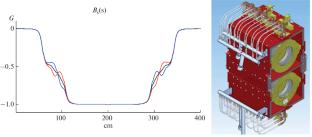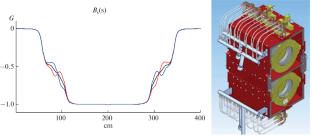High Energy Electron Cooling System for the NICA Collider
IF 0.4
Q4 PHYSICS, PARTICLES & FIELDS
引用次数: 0
Abstract
Electron cooling of ion beams plays a key role in the NICA collider project. To achieve the required luminosity, it is important to ensure effective cooling during beam accumulation and the experiment. To this end, the NICA complex design provides stochastic and two electron-cooling systems. The electron cooler for the NICA booster manufactured at the Budker Institute of Nuclear Physics (BINP SB RAS) has already shown its efficiency at the injection energy. Some basic concepts underlying the construction of a 2.5 MeV cooler for collider NICA that can operate at the experiment energy to increase the luminosity of the complex are described.


NICA对撞机高能电子冷却系统
离子束的电子冷却在NICA对撞机项目中起着关键作用。为了达到所需的亮度,在光束积累和实验过程中保证有效的冷却是很重要的。为此,NICA复杂的设计提供了随机和两个电子冷却系统。Budker核物理研究所(BINP SB RAS)制造的NICA助推器的电子冷却器已经显示出其在注入能量方面的效率。描述了用于NICA对撞机的2.5 MeV冷却器的一些基本概念,该冷却器可以在实验能量下工作以增加复合物的光度。
本文章由计算机程序翻译,如有差异,请以英文原文为准。
求助全文
约1分钟内获得全文
求助全文
来源期刊

Physics of Particles and Nuclei Letters
PHYSICS, PARTICLES & FIELDS-
CiteScore
0.80
自引率
20.00%
发文量
108
期刊介绍:
The journal Physics of Particles and Nuclei Letters, brief name Particles and Nuclei Letters, publishes the articles with results of the original theoretical, experimental, scientific-technical, methodological and applied research. Subject matter of articles covers: theoretical physics, elementary particle physics, relativistic nuclear physics, nuclear physics and related problems in other branches of physics, neutron physics, condensed matter physics, physics and engineering at low temperatures, physics and engineering of accelerators, physical experimental instruments and methods, physical computation experiments, applied research in these branches of physics and radiology, ecology and nuclear medicine.
 求助内容:
求助内容: 应助结果提醒方式:
应助结果提醒方式:


